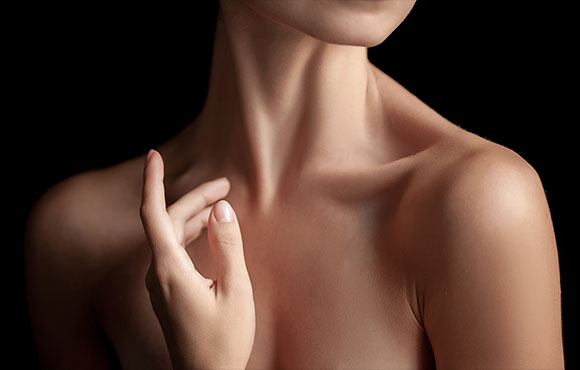Neck Lift
As we age, however well we look after our face with a myriad of creams and potions, it is often our neck that gives it all away. The steady decline in collagen and elastin results in sagging skin that doesn’t have that youthful snapback. Sun damage causes the neck to take on a crepey texture. Along with loosening of skin some also develop neck bands due to tethering of the skin along the muscular plane known as the platysma. The platysma is a thin sheet of muscle that lies just below the skin. To cap it all off we lose the profile of our neck even further following ups and downs in our weight, that can result in fat accumulating below the chin.

What treatments can help to improve the skin of the neck?
There are a number of non-invasive treatments available to improve the skin and profile of the neck. However, the effects are all limited. The skin of the neck can be improved through the use of mesotherapy such as multiple sessions of hyaluronic acid skin booster shots. Skin boosters help to plump up the skin and improve the crepey nature of the neck and decolletage regions. Wrinkle relaxing injections are used to treat platysmal neck bands. In the US and Australia, Kybella injections have become very popular. Kybella can be injected into fat deposits below the chin and in the neck and help to break down the fat. Results are impressive but multiple sessions are needed. Kybella is also extremely expensive with a full course costing between $5000 to $10000. Kybella is still not available in the UK. Ultrasound based technologies such as HiFU and 3D Lipo Med have demonstrated some success in improving the profile of the neck but again multiple sessions are required and results vary. Laser lipo has been touted as ‘lunch time lipo’ and a great option for improving the tone and profile of the neck but this can be associated with significant complications, especially in the wrong hand
What can a thread lift do for the neck?
Threads can be used to great effect in the neck. At Rejuvence Clinic we are able to offer two thread lift options – PDO Threads and Spring Thread®.
PDO threads can be used to help tighten the neck, improve the profile and provide a collagen boost. PDO threads improve the texture and often crepey nature of the skin around the neck. PDO threads are absorbed within 3 months of insertion and are replaced by strands of collagen. An additional benefit of PDO threads is it’s lipolytic properties. This means that PDO threads are able to break down fatty deposits. The effects of PDO threads last for up to 18 months.
The Spring ThreadⓇ is a much stronger and permanent thread. It is a biocompatible silicone based thread with moulded cogs. Spring Thread® can be inserted into either side of the neck and lift and tighten the skin much more effectively than PDO threads. They also stimulate new collagen production that will rejuvenate the overlying skin. Neck lifts with Spring Thread® last for 3 to 5 years and can be repeated.
How is Thread Lift carried out in the neck?
Different techniques are used for placement of PDO threads and the Spring ThreadⓇ in the neck. Prior to starting the procedure a topical numbing cream is applied to the neck. The neck is cleaned and prepped and the thread routes marked up with a marker pen.
PDO Threads
With PDO threads a small amount of local anaesthetic is injected at the thread insertion points either side of the neck. Multiple threads are then inserted using a cannula technique to create a net effect. Where necessary ultrasound imaging is used to ensure the threads are placed in the correct level. A variety of different types of PDO threads are used depending on what we are trying to achieve. Cog threads are used to achieve some immediate lift and tightening. However, flat and twisted threads for maximum collagen induction, often produce the best results. This procedure can be repeated 12-18 months later.
Spring Thread®
With Spring Thread® the anchoring points are located over the ‘mastoid process’. This is a bony prominence located just behind the ear. A small amount of anaesthetic is injected onto this point to numb the area. Tumescent anaesthetic technique is then used to numb the entire neck making the procedure pain free. A single Spring Thread® is inserted through a ligament overlying the mastoid process and then subsequently just below the skin of the neck. This is repeated on the other side. Finally the threads are tightened and the skin of the neck lifted and tightened. Following the procedure a compression garment is applied and should be kept on for 3 days.
Treatments available at Rejuvence Clinic for neck rejuvenation
What is J-Plazty Neck?
PDO thread neck lift is good but if you want an even better result consider J-Plazty Neck. At Rejuvence we are the first and only clinic in the UK to offer the J-Plazty neck tightening procedure. This is a revolutionary procedure that has taken the US by storm. J-Plazty uses the power of J-Plasma from Renuvion. This is the premier skin tightening technology available on the market. It is a minimally invasive procedure that can be carried out under local anaesthetic. In combination with VASER liposuction, fat can be removed from below the chin and neck and skin tightened using the power of helium based J-Plasma. The results of J Plazty neck are far superior to non-invasive techniques. Compared to a surgical neck lift J-Plazty neck can yield similar results in cases of moderate skin laxity and does not require a general anaesthetic, shorter treatment time, quicker downtime with less pain and bruising. Of course it costs much less than a surgical neck lift. Click here to find out more.
As with PDO threads, the Spring Thread® is a relatively safe procedure. Despite being substantially thicker than PDO threads, as long as they are inserted into the right area and sufficiently deep, the threads are not visible through the skin. In the neck there is a higher chance of bruising than the face. This normally resolves within a week. With Spring ThreadⓇ it is very important to maintain excellent sterile technique throughout. Antibiotics are routinely provided afterwards. It is also extremely important to maintain excellent hygiene to reduce the risk of infection. Those with pets at home should not be considering this treatment as the risk of infection is much higher. If need be the threads can be removed and readjusted but this is usually extremely rare.
The risk of complications is quite low in a safe pair of hands. The most common complication associated with PDO thread lifts is bruising. In addition the neck has some very important structures and it is very important that care is taken when placing the threads. At Rejuvence we go a step further and use ultrasound guidance to aid us with thread placement and to be doubly sure we don’t damage any major blood vessels as we go in. Ultrasound allows us to view all structures in the neck whilst the threads are being placed. We are also able to ensure threads are being placed in the right plane to achieve the best possible result.













